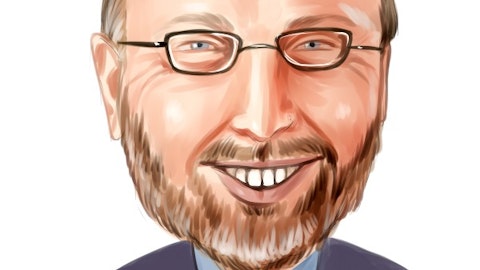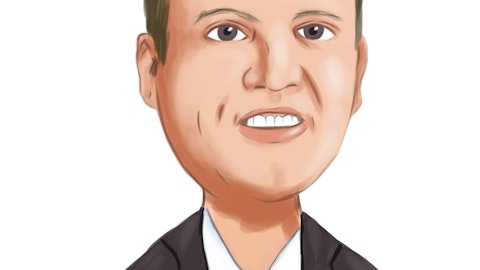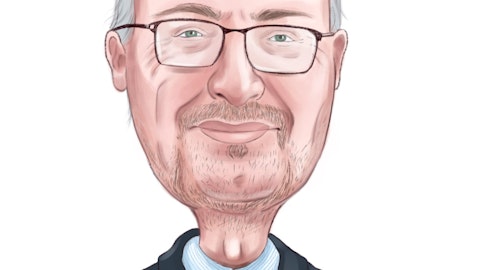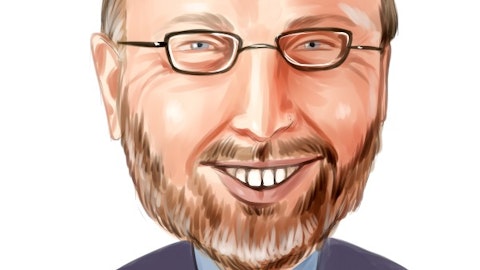Verint Systems Inc. (NASDAQ:VRNT) Q3 2023 Earnings Call Transcript December 7, 2022
Verint Systems Inc. beats earnings expectations. Reported EPS is $0.69, expectations were $0.59.
Operator: Good day and thank you for standing by. Welcome to the Verint Third Quarter Conference Call. At this time, all participants are in a listen-only mode. After the speakers’ presentation, there will be a question-and-answer session. Please be advised that today’s conference is being recorded. I would now like to hand the conference over to your speaker today Matthew Frankel. Please go ahead.
Matthew Frankel: Thank you, operator. Good afternoon, and thank you for joining our conference call today. I’m here with Dan Bodner, Verint’s CEO; Doug Robinson, Verint’s CFO; and Alan Roden, Verint’s Chief Corporate Development Officer. Before getting started, I’d like to mention that accompanying our call today is a Slide presentation. If you’d like to view these slides in real-time during the call, please visit the IR section of our website at verint.com, click on the Investor Relations tab and click on the Webcast link and select today’s conference call. I’d also like to draw your attention to the fact that certain matters discussed on this call may contain forward-looking statements within the meaning of the Private Securities Litigation Reform Act of 1995 and other provisions of federal securities laws.
These forward-looking statements are based on management’s current expectations that are not guarantees of future performance. Actual results could differ materially from those expressed in or implied by these forward-looking statements. The forward-looking statements are made as of the date of this call, and as except as required by law, Verint has no obligation to update or revise them. Investors are cautioned not to place undue reliance on these forward-looking statements. For more detailed discussion on how these and other risks and uncertainties could cause Verint’s actual results to differ materially from those indicated in these forward-looking statements, please see our Form 10-K for the fiscal year ended Jan 31, 2022. Our Form 10-Q for the quarter ended October 31, 2022, when filed and other filings we make with the SEC.
The financial measures discussed today include non-GAAP measures as we believe investors focus on those measures in comparing results between periods and among our peer companies. Please see today’s slide presentation, our earnings release in the Investor Relations section of our website at verint.com for a reconciliation of non-GAAP financial measures to GAAP measures. Non-GAAP financial information should not be considered in isolation from, as a substitute for or superior to GAAP financial information, but is included because management believes it provides meaningful supplemental information regarding our operating results when assessing our business and is useful to investors for informational and comparative purposes. The non-GAAP financial measures the company uses have limitations and may differ from those used by other companies.
Now I’d like to turn the call over to Dan. Dan?
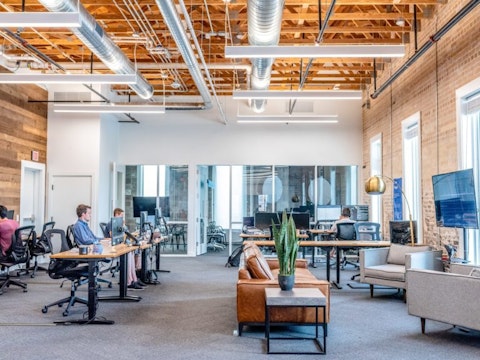
Photo by Austin Distel on Unsplash
Dan Bodner: Thank you, Matt. I’m pleased to report another quarter with continued strong sales momentum across key metrics driven by brands looking to close the engagement capacity gap. Verint cloud’s platform is differentiated especially for organizations looking to elevate customer experience with the same resources and budgets. Ongoing changes in workforce dynamics make it more compelling for brands to deploy AI-driven solutions to increase their workforce effectiveness. Throughout this year, we have experienced strong sales growth with our cloud platform driving increased recurring revenue and sequential gross margin expansion. Today, we will review our Q3 and year-to-date financial results and provide an update on recent market trends.
We will also discuss our guidance for this year and introduce our outlook for next year. We expect continued SaaS revenue growth, perpetual revenue decline and gross margin expansion driving strong earnings growth. Let’s take a closer look at our Q3 results. Starting with revenue, in Q3, we delivered revenue in line with our prior guidance. Our gross margins have increased throughout the year tracking ahead of plan and our non-GAAP diluted EPS came in significantly ahead of our guidance. We are pleased with our overall results and especially with our sales growth metrics. Cloud revenue increased 35% in Q3 with the SaaS portion of cloud revenue growing over 40% on a constant currency basis versus last year. Cloud bookings also came in strong with new SaaS ACV bookings growing in Q3 over 50% year-over-year on a constant currency basis.
As a reminder, in Q2, our new SaaS ACV had single-digit growth due to a tough compare and we guided to strong Q3 growth, which we are pleased to have delivered. Driving our strong new SaaS ACV growth where many customer expansions and new logos. In Q3, we received 31 cloud orders in excess of $1 million TCV as large enterprise customers continue shifting to the cloud. This is about a 50% increase, compared to 21 orders in the same quarter last year and reflects the trend of large enterprises adopting cloud. These large cloud orders included some of the more recognizable organizations in the world such as financial services provider Discover; home goods retailer IKEA; and healthcare provider Cardinal Health. In addition, we continue to win many new customers and in Q3 we again added more than 100 new logos, including the grocery company Kroger and food delivery company, Grubhub.
Let’s take a closer look at two large seven and eight digit wins in Q3. The first order for $13 million was from a leading financial services company. This large customer decided to move to the cloud and selected Verint’s cloud platform. We believe we won this large order due to our platform openness, Da Vinci AI differentiation and enterprise scalability. And the second order for $7 million was from a leading company in the utility sector. This large organization, which serves several million customers across the U.S. is also moving to the cloud use Verint and adding new applications across the Verint cloud platform. We believe the openness and breadth of the platform, Da Vinci AI automation and differentiation and a strong ROI were key reasons we won this opportunity.
As discussed on prior calls, the Verint cloud platform is differentiated across multiple backstores. First, the platform core includes our market leading engagement data hub and Verint Da Vinci AI that underpins all the applications running on our platform. This data centric approach empowers our customers with business insights and drives automation across the enterprise. Second, our platform offers many best of breed applications to help brands close the engagement capacity gaps and generate quick ROI. The platform approach makes it easy for customers to start anywhere and adopt additional applications over time. And third, our platform is open and agnostic to a brand choice of telephony solution, CRM solution and data lakes, where it makes it easy for brands to deploy our platform into their existing ecosystem.
Next, I would like to discuss the SaaS revenue and SaaS bookings trends we have seen this year and our expectations for the remainder of fiscal 23. Our SaaS revenue has consistently increased over the last few years, and this year, we expect over 35% growth on a constant currency basis. Throughout this year, our SaaS revenue has increased every quarter, and we expect to finish this year strong with non-GAAP SaaS revenue approaching $130 million in Q4. With respect to bookings, we expect strong new SaaS ACV growth in Q4 following our strong growth in Q3. Overall, the second half, we expect around 40% growth year-over-year, an acceleration over the 15% growth we saw in the first half on a constant currency basis. SaaS bookings accelerate in H2 we see the opposite trend in perpetual license bookings, which I will discuss next.
In Q3, we saw a change in behavior from perpetual license customers. Our perpetual revenue in Q3 was significantly lower than in Q1 and Q2. We expect this trend to continue in Q4. Looking at the second half of the current year, we expect perpetual revenue to drop to $46 million, which is a faster decline than previously expected. For the full-year, we now expect $110 million of perpetual revenue. As the market shifts away from perpetual to SaaS, our recurring revenue metrics continue to be strong. For the year, we expect non-GAAP recurring revenue to increase around 10% on a constant currency basis. For Q4, given the perpetual trends we just discussed, we expect close to 90% of our non-GAAP software revenue to come from recurring sources. As a greater portion of our revenue is recurring, visibility has improved and we also benefit from gross margin expansion, as I will explain next.
Throughout this year, we have experienced a sequential improvement in gross margins. Our recurring revenue generates much higher gross margins than our non-recurring revenue and recurring revenue growth has been driving gross margin expansion. Overall, we expect around 100 points of expansion this year with a non-GAAP annual gross margin reaching 70% for the first time in our SaaS transition. Turning to guidance for the current year. In Q4, as SaaS revenue continues to grow, we expect perpetual revenue to decline faster than we previously expected and are adjusting our annual revenue outlook accordingly to 5% growth on a constant currency basis. Regarding EPS, we are maintaining our guidance for 10% diluted EPS year-over-year growth. Next year’s guidance is driven by the trends and market environment we are seeing today.
We expect another year of strong sales momentum with 30% SaaS revenue growth on a constant currency basis, while potential revenue declines to approximately $100 million. Overall, this drives our total revenue growth to 6% on a constant currency basis, up from 5% we now expect for this year. We expect another year of gross margin expansion as we continue our shift towards recurring revenue. And regarding EPS, we expect 8% year-over-year growth resulting in diluted EPS of $2.70. Before handing the call over to Doug, let me conclude with our long-term targets and new buyback program. We believe that helping brands close the engagement capacity gap is a growth opportunity that will support strong SaaS revenue growth for many years. In addition, we believe our gross margins will continue to expand as we shift to SaaS, which will enable us to drive strong double-digit earnings growth long term.
We are confident in our long-term prospects and are pleased to announce a new $200 million stock buyback program over the next two years. And before I turn over the call to Doug, I would like to remind you of the previously announced CFO transition in Q4. This is the last earnings call that Doug joins as our CFO, and a great opportunity for me to thank Doug with tremendous contribution to Verint over the last 16 years and for the flawless execution of our complex spinoff almost two years ago. Now let me turn the call over to Doug.
See also 12 Monthly Dividend Stocks Under $10 and 15 Best Cybersecurity Stocks To Buy.
Doug Robinson: Thanks, Dan. Good afternoon, everyone. Our discussion today will include non-GAAP financial measures. A reconciliation between our GAAP and non-GAAP financial measures is available, as Matt mentioned, in our earnings release and in the IR section of our website. Differences between our GAAP and non-GAAP financial measures include adjustments related to acquisitions, including fair value revenue adjustments, amortization of acquisition-related intangibles, certain other acquisition-related expenses, stock-based compensation expenses, separation-related expenses, accelerated lease costs, IT facilities and infrastructure realignment, as well as certain other items that can vary significantly in a mountain frequency from period to period.
For certain metrics, it also includes adjustments related to foreign exchange rates. Similar to last quarter, given the significant appreciation of the U.S. dollar this year, I’ll be discussing certain results on a constant currency basis today to better understand our business performance. Revenue came in at $232 million on both a GAAP and non-GAAP basis, in line with our prior guidance, reflecting 2% year-over-year growth on a non-GAAP currency basis. Year-to-date non-GAAP revenue increased 6% on a constant currency basis. Recurring revenue came in at $175 million on both the GAAP and non-GAAP basis, reflecting 12% year-over-year growth on a non-GAAP constant currency basis. Year-to-date, non-GAAP recurring revenue increased 11% on a constant currency basis.
As Dan discussed earlier, as we shift to a more recurring revenue model, we are seeing an improvement in our gross margins. And our non-GAAP gross margin came in strong at 71.2% in Q3. Our strong gross margins enabled us to significantly overachieve on the bottom line and non-GAAP diluted EPS came in at $0.69. Turning to our strong cloud KPIs. We’re very pleased with our Q3 and year-to-date performance. Cloud revenue on a constant currency basis increased 37% on a GAAP basis and 35% on a non-GAAP basis year-over-year in Q3, slightly faster growth than the first half of the year. Non-GAAP SaaS revenue on a constant currency basis increased 41% year-over-year in Q3 or 44% on a GAAP constant currency basis. Both metrics grew strongly in Q3 with a growing faster than cloud.
As we previously discussed, cloud includes optional managed services, which is a low-margin business that we’re not targeting for growth. New SaaS ACV bookings represents annualized contract value of all new SaaS contracts booked in the quarter. In Q3, new SaaS ACV was up strong at 51% year-over-year on a constant currency basis, as we continue to see strong demand across industries and geographies as well as new and existing customers for the Verint Cloud platform. As Dan discussed earlier, in Q3, perpetual revenue declined more than expected, which resulted in new PLE bookings being down 4% year-over-year on a constant currency basis. Year-to-date, new PLE bookings increased 11% on a constant currency basis. Given the trends we discussed today, I’d like to mention that it’s useful to look at two components in PLE, perpetual and SaaS, which demonstrate different behaviors.
In Q3, the SaaS component increased 42%, while the perpetual component declined 43%. And year-to-date, we experienced 41% growth in the SaaS component, while the perpetual component declined 20%. I’d now like to discuss our current guidance for Q4 and the year ending January 31, 2023. We expect another quarter of SaaS growth in Q4, driving more than 35% SaaS revenue growth and 10% recurring revenue growth for the year, both on a constant currency basis. We expect revenue to increase sequentially by around $6 million in Q4 and are adjusting our outlook for total revenue for the year to $900 million or 5% year-over-year growth on a constant currency basis. Our current outlook reflects the trends we discussed today, including strong SaaS growth, coupled with faster-than-expected perpetual decline.
Our current outlook for perpetual revenue is approximately $110 million. With respect to EPS, we are maintaining our guidance for 10% diluted EPS growth year-over-year. In Q4, below the line, we expect interest and other expense net should be around $1 million. Net income from a non-controlling interest we have in the small joint venture should be around $200,000. Our cash tax rate should be about 12%, and we expect around 76 million fully diluted shares outstanding. Before moving to our outlook for next year, let me take a minute to review where we are in our cloud transition across three areas and discuss how we’re modeling next year’s SaaS growth. Starting with the cloud mix. Over the next several years, our revenue and bookings have steadily shifted to SaaS.
This year, we expect cloud revenue to represent 64% of our cloud software revenue. Regarding bookings, we expect 67% of new PLE bookings to come from SaaS. We’re pleased with our continued progress with our mix change towards SaaS. Next, I’d like to discuss SaaS revenue. As we look at our expected 35% SaaS revenue growth. We expect around 60% of our growth to come from new business and 40% to come from conversions. At the end of this year, we expect to have $180 million of support revenue remaining, which we expect to convert to SaaS over time. Third, our recurring mix of revenue continues to increase and we expect around 86% of our software revenue to come from recurring sources this year, driven by new SaaS ACV bookings and strong renewal rates.
Overall, I believe we’re well positioned going to next year for continued SaaS growth. Now let’s turn to our guidance for next year. Our fiscal 24 guidance reflects the trends we discussed today, including strong SaaS bookings, declining perpetual, as well as the current macro environment, which may be impacting customer and partner buying decisions. For total revenue, we expect 6% year-over-year growth on a constant currency basis, resulting in $945 million of reported revenue, plus or minus 2%. We expect recurring revenue to grow close to 10% year-over-year on a constant currency basis with perpetual revenue coming in around $100 million. We expect gross margins and operating margins to continue to expand and deliver 8% fully diluted EPS growth.
Now let’s discuss some below-the-line assumptions. We expect around $750,000 per quarter of interest and other expense net. We expect about $200,000 per quarter of net income from a non-controlling interest we have in a small joint venture. We expect the cash tax rate of approximately 11% for each quarter and for the year. And our guidance assumes 75 million fully diluted shares, down slightly from the year due to the new buyback program. The actual share count will depend on the pace of the buyback. In summary, we’re pleased with our Q3 and year-to-date results and are well positioned for a strong finish to the year. We expect the strong SaaS momentum we experienced this year to continue into next year, driving another year of strong earnings growth.
Longer term, we are operating in a favorable market that supports sustainable SaaS growth from which we expect to drive double-digit total revenue growth, continued margin expansion and double-digit earnings growth. Our new $200 million share buyback program, which at current prices could allow us to repurchase approximately 7% of our outstanding shares reflects the confidence we have in our outlook. And finally, as this is my last earnings call as CFO of Verint, I’d like to share that I couldn’t be more confident in grant in our team and look forward to acting as an adviser to stay in the company for a period of time. And with that, operator, let’s open up the line for questions.
Q&A Session
Follow Verint Systems Inc (NASDAQ:VRNT)
Follow Verint Systems Inc (NASDAQ:VRNT)
Operator: Our first question will come from the line of Shaul Eyal from Cowen. Your line is open.
Shaul Eyal: Thank you. Good afternoon, gentlemen. So a healthy quarter on the cloud front, yet next year’s guidance is coming below consensus. Maybe can you reconcile for us the tale of 2 cities, so to speak? Is it a transition which is taking away from next year’s revenue is seeing headwinds? Or is it just a macro weighed in? And maybe if on the macro front, do you think that you’ve taken the necessary measures to tackle a moderating economy as you see it right now?
Dan Bodner: Yes. Thanks for the question. So let me start by how we see the macro environment today, and of course, that we guide into next year. So clearly, a very, very strong Q3 on all metrics. SaaS revenue up 40% on a constant currency basis. SaaS booking the new SaaS ACV 51%, so not just revenue, but also booking strength, which is leading metric. 100-plus new logos, large deals up 50%, (ph) over $1 million. So right now, when we look at how we execute on our cloud strategy, clearly, the platform is driving customers to the cloud, and our goal is to help our customers complete their SaaS position. And we think we’re doing well in Q3 and also in Q4. When we look at the Q4 guidance that we just gave, we expect SaaS bookings to grow in H2, 40%.
So continue to be strength. I spoke about the platform differentiation. It’s an enterprise-wide platform, it’s about CX automation. It’s not about telephony or CRM. So it’s very differentiated. And customer partners love it because it’s quick time to value. And in this environment, when they’re looking to reduce the cost of the workforce, this is exactly what they need. They need to elevate CX with automation and workforce efficiency. So that’s kind of the backdrop for what we see now. Now as you mentioned on the perpetual, very clear change in Q3, where the perpetual license revenue are down, both booking and revenue and sharply down from H1. So if you look at the H1 numbers, this was a run rate of $130 million perpetual — and now in Q3, we are at the run rate of $100 million, so about $25 million in Q3, it’s $100 million of run rate.
And in Q4, it’s going to be about the same. So a very short job potentially related to CapEx budgets and macro. But what’s interesting, as we speak to these customers, and they have been customers for Verint for a long time, we didn’t lose the deals. And when they come back, I believe some of them will come back as SaaS. So these are customers that before indicated, that it will take them a while to move to the cloud, and now they are more seriously considering transition to SaaS next year. So I think overall, the macro is favorable for SaaS, and we give a lot of metrics today to measure the progress of our SaaS mix. So now bridging into next year, on the recurring revenue side, we do expect to see 10% growth on a constant currency basis, so recurring revenue will grow nicely to $750 million.
But perpetual, we are assuming $100 million and professional services usually 1:1 ratio with perpetual, so that’s the balance. So when you think about this, obviously, perpetual has a big impact on the guidance change. FX is another impact, about 1% next year. And the balance is what we’re assuming in terms of SaaS booking next year, the assumption behind the guidance is 15% New SaaS ACV booking. That’s obviously lower than H2. In H2, now we have 40%, but I think that’s the main assumption that drive the balance of the guidance and that’s top line, right? So just to finish the way we think about it, we — in addition to continue to motivate our customers to move to SaaS, which we’ve done since the spin and continue to do into this economy, we also see a very nice margin expansion.
Q3 gross margin are 71%, we expect Q4 gross margin to continue to expand from there. So the mix between recurring and non-recurring, as Doug mentioned before, is creating a good uplift on gross margin. And that, coupled with expense management, we are able to continue to grow earnings much faster than we’re growing the top line this year, and that’s also our plan for next year, as we guided for $2.70, which is 8% growth. So in summary, we think next year is two objectives: Accelerate the cloud transition and have a very strong SaaS growth, 30% SaaS revenue growth and also manage the bottom line. Of course, we have an FX, we have natural hedge, as you know, and we manage the gross margin and cost structure to accelerate earnings faster than revenue.
Shaul Eyal: Got it. And thank you for this elaborated reply. As we think about some of those elongated sales cycles, can you identify for us maybe is that a vertical driven? Is that specifically macro-driven? How should we be thinking about it? And understanding that for now, and again, correct me if I’m wrong, nothing is getting canceled, but rather pushed. I’m pleased, you know, correct me if I’m wrong. But is it coming from one industry or it’s pretty much broad-based?
Dan Bodner: Yes. So I would say, first, we don’t see elongated sales cycle across every customer. There are some customers actually that are looking to accelerate because they see ROI and they need new technology. Well, other customers, they obviously take the time because they want to be more careful in spending. And clearly, as we discussed — as I discussed before, the — there’s a CapEx OpEx difference here that is very visible in terms of the longer sales cycle. But if I look at other — like you mentioned verticals and so I’ll start with geographies. Year-to-date, what we see in Americas, EMEA and APAC is very similar. So I can say no change in — by geography. In terms of verticals, we are very diversified across verticals, OSB Financial services continue to be strong.
Health care continues to be a strong part of our business. These are large B2C companies, and we had seven and eight digits wins with these companies moving to the cloud. So I think it’s more a customer-by-customer decision. When I look back at our recession in 2008, where we did really well, we grew a little bit, and we grew earnings a lot in 2008. And it was — obviously, we’re diversified. We have larger enterprise customers and we also very sticky solutions. But also, it was very clear that this type of B2C companies need to engage with their customers in good times and in bad times, and especially when the workforce costs are increasing, and they need technology to increase automation, while elevating CX. So I think that’s the dynamic.
